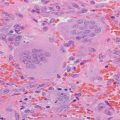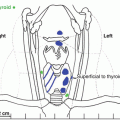MEN 1
MEN 2a
NSHPT/FHH
HPT-JT
FIHP
Clinical features
PHPT
Pancreatic/duodenal tumors
Pituitary tumors (functioning and nonfunctioning)
Skin findings (angiofibromas, collagenomas)
PHPT
Medullary thyroid carcinoma
Pheochromocytoma
PHPT
Severe hypercalcemia in NSHPT
Mild hypercalcemia in FHH
Low urine calcium
PHPT
Fibro-osseous jaw tumors
Uterine tumors
Renal tumors
PHPT
Genes affected
MENIN
RET
CaSR
HRPT2/CDC73
Elevated serum calcium with an elevated or inappropriately normal PTH is the hallmark biochemical feature that establishes the diagnosis of PHPT in children. This must be distinguished from secondary HPT that is commonly due to vitamin D and or calcium deficiency leading to elevated PTH concentrations with low-normal or low serum calcium levels. When evaluating a child with hypercalcemia, it is important to be aware that the normal ranges for serum calcium and phosphorus differ based on age and gender (Table 14.2). Healthy infants and children have higher calcium and phosphorus concentrations compared to adults. This finding will influence the interpretation of laboratory studies, especially in children with mild calcium and parathyroid abnormalities. Urine calcium should also be interpreted with the age of the child in mind. Older children can often provide a 24-h urine sample in which case an upper limit of normal of 4 mg/kg/day can be applied. In infants and younger children, a calcium-to-creatine ratio on a spot urine sample can be used (Table 14.2). Some patients may also have hypophosphatemia, due to the action of PTH in the kidney and an elevated serum alkaline phosphatase, especially with documented bone involvement.
Table 14.2
Age- and gender-appropriate normal values
Normal values | |
|---|---|
Serum total calcium, males | |
1–14 years | 9.6–10.6 mg/dL |
15–16 years | 9.5–10.5 mg/dL |
17–18 years | 9.5–10.4 mg/dL |
19–21 years | 9.3–10.3 mg/dL |
≥22 years | 8.9–10.1 mg/dL |
Serum total calcium, females | |
1–11 years | 9.6–10.6 mg/dL |
12–14 years | 9.5–10.4 mg/dL |
15–18 years | 9.1–10.3 mg/dL |
≥19 years | 8.9–10.1 mg/dL |
Serum inorganic phosphorus, males | |
1–4 years | 4.3–5.4 mg/dL |
5–13 years | 3.7–5.4 mg/dL |
14–15 years | 3.5–5.3 mg/dL |
16–17 years | 3.1–4.7 mg/dL |
≥18 years | 2.5–4.5 mg/dL |
Serum inorganic phosphorus, females | |
1–7 years | 4.3–5.4 mg/dL |
8–13 years | 4.0–5.2 mg/dL |
14–15 years | 3.5–4.9 mg/dL |
16–17 years | 3.1–4.7 mg/dL |
≥18 years | 2.5–4.5 mg/dL |
Random urine calcium/creatinine ratio | |
0–12 months | <2,100 mg/g |
13–24 months | <450 mg/g |
25 months–5 years | <350 mg/g |
6–10 years | <300 mg/g |
11–18 years | <260 mg/g |
≥19 years | <220 mg/g |
A recent review of the biochemical profile of children and adolescents with PHPT found a greater degree of hypercalcemia and hypercalciuria at presentation compared to adults despite similar parathyroid hormone concentrations. Furthermore, adenoma weight and alkaline phosphatase activity among age groups did not reveal significant difference. These observations suggest a possible greater sensitivity of target organs to PTH and an apparent decrease in the sensitivity of the parathyroid adenoma to negative feedback by calcium in young patients with PHPT [4, 9].
PHPT (especially sporadic) in children is associated with greater morbidity and end-organ damage at the time of diagnosis compared to adults. Most modern-day adult cohorts are asymptomatic and diagnosed incidentally [4, 9, 10], while as many as 79–91 % of children with PHPT present with symptoms attributable to the disease [3, 7, 11]. Another significant difference of juvenile compared with adult PHPT is the presence of end-organ damage at the time of diagnosis, the most common of which are renal and skeletal involvement [3, 11]. Bone disease, presenting as bone pain, radiographic evidence of osteopenia and osteolysis, diminished bone densitometry or fractures, occurs in about 43 % of children. Nephrolithiasis or nephrocalcinosis, at times leading to chronic kidney disease, is present in about 39 % [3, 4, 11]. Nonspecific symptoms such as fatigue, poor appetite, weight loss, depression, hypertension, polyuria, polydipsia, abdominal pain, nausea, and vomiting may be the only manifestations of the disease or they may be associated with end-organ damage [3, 4, 11]. About 15 % of patients were asymptomatic at the time of diagnosis and were only discovered following an incidental finding of hypercalcemia [4]. This distinct clinical history of PHPT in children and adolescents may be attributed to several factors. Because routine biochemical screening is not performed as commonly in children as in adults, a degree of ascertainment bias may arise. As such, a diagnosis of PHPT is made only when the disease becomes symptomatic which is more reminiscent of PHPT in adults prior to the routine measurement of serum calcium [1, 12, 13]. Lack of specific symptoms may also lead to a delay in the appropriate diagnosis in many patients. The average delay occurring between the onset of symptoms and diagnosis ranges from 7.2 months to as long as 4.7 years in children [3, 7, 14]. Patients without renal symptoms had a longer duration of symptoms before a diagnosis of PHPT was secured. This significant delay in diagnosis unfortunately leads to more end-organ damage in this population.
Stay updated, free articles. Join our Telegram channel

Full access? Get Clinical Tree





